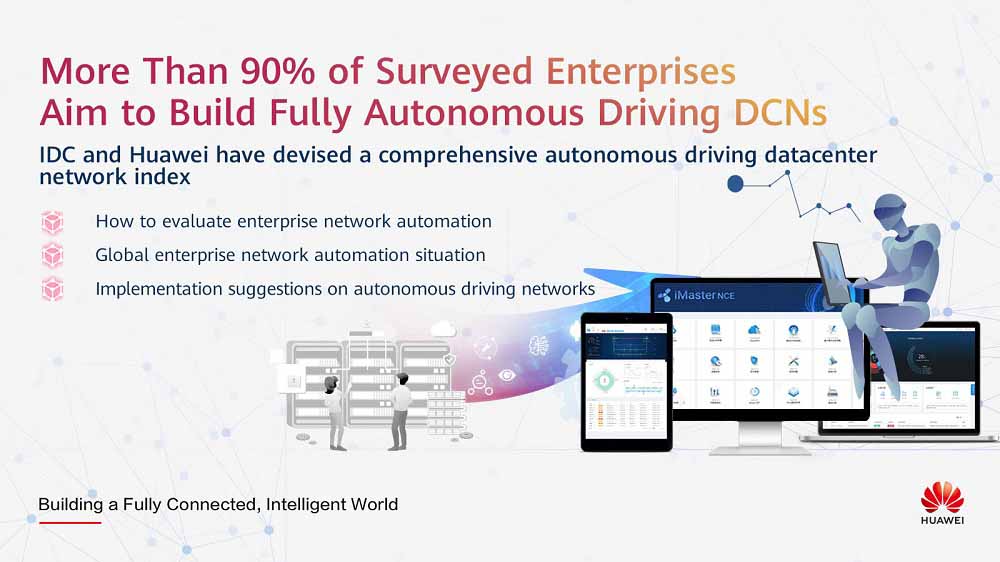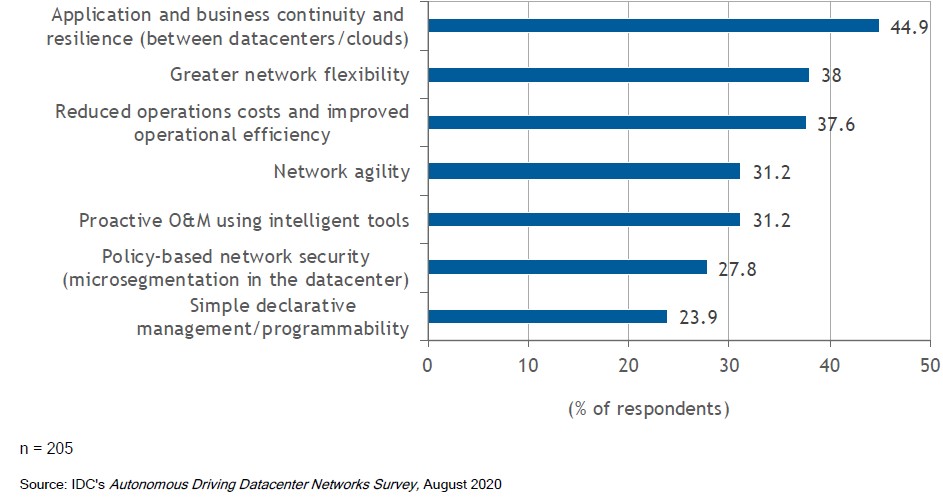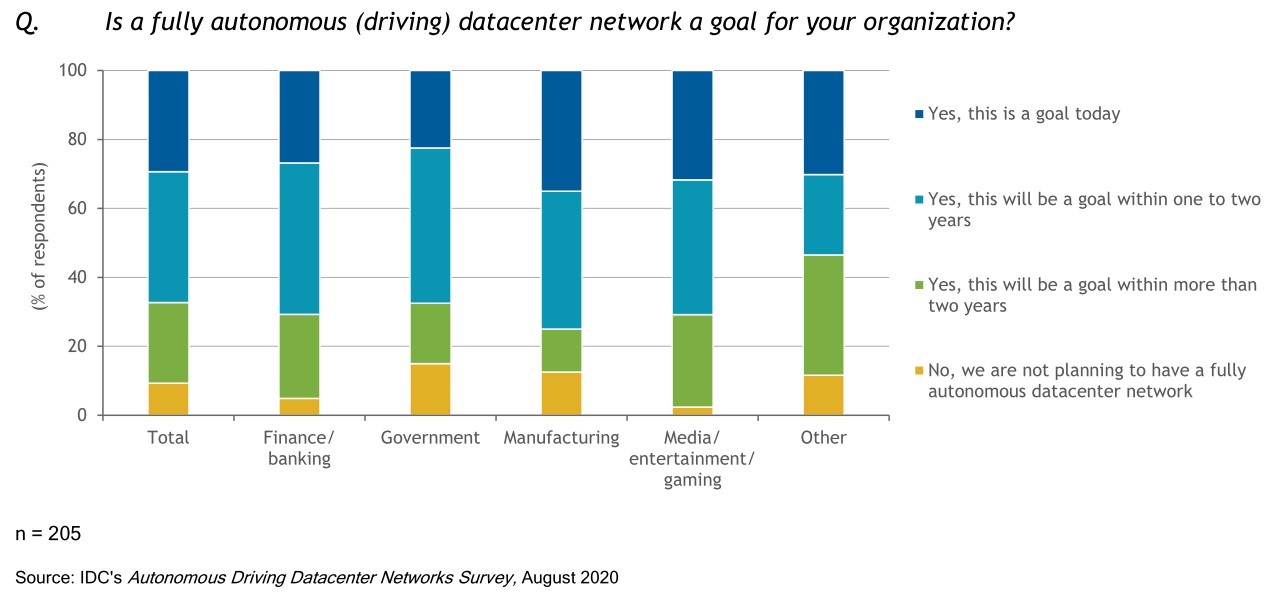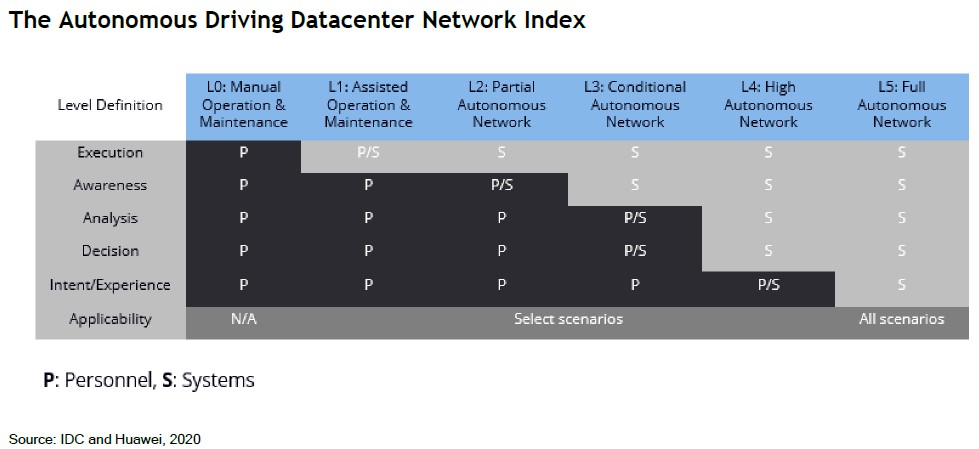































[Shenzhen, China, December 22, 2020] Over 90% of enterprises claim that they pursue fully autonomous networks for service agility, flexibility, and cost-effectiveness, according to key findings of IDC's newest survey white paper Leveraging the Autonomous Driving Datacenter Network Index sponsored by Huawei. As highlighted in the report, the autonomous driving data center network helps enterprises reconstruct the network architecture and operation mode and enhance service resilience and continuity. This insightful report also provides some suggestions on how enterprises can promote and gradually achieve comprehensive automation, regardless of their current DCN automation levels.

The race for innovation has begun. In the cloud era, legacy data center networks that provide only connections and bandwidth required by service applications cannot meet requirements. Data center networks are at a critical turning point for change.
To better understand the automation level, challenges, and opportunities of enterprise data center networks, Huawei commissions IDC to survey the current status of data center networks of 205 enterprises in different industries and with different network scales, define the levels of data center network automation, and explore the feasible ways to implement full automation.
Today, applications and service systems have become the lifeline of enterprises, and new application requirements and service changes are emerging continuously. In particular, the emergence of the cloud operation mode and cloud-native application architecture brings unprecedented challenges to enterprise data center networks. Data center networks need to realize scalability and high performance, and achieve higher agility and flexibility through extensive automation.
"Enterprises are increasingly recognizing the value of data center network automation, including its ability to increase service resilience and continuity, as the data center network provides the digital nervous system to support applications and service systems," Brad Casemore, IDC's Research Vice President, Datacenter Networks, said.
IDC asked respondents to identify what was driving their need for data center network automation. At the top of the list was application and business continuity and resilience (between datacenters/clouds), which was cited by about 45% of respondents. IDC believes this result was accentuated by the COVID-19 pandemic, which has caused organizations to prioritize business resilience and continuity as they focus on keeping the digital lights on during an unforeseen crisis.

According to the survey results, about 48% said they used automated management tools such as Ansible, Puppet, Chef, Salt, and Terraform. Meanwhile, 19% indicated using command lines/SNMP. Only 6.3% of respondents claimed to be using "a closed-loop intent-based network, an autonomous driving network, or another self-driving network".
However, from the industry perspective, all surveyed industry customers are performing data center network automation or have plans to do so. Only 40% of government customers have deployed or are deploying data center network automation, which lags behind other industries.
In terms of scale, enterprises with three or more data centers will go further on the road to network automation. 72.5% of the respondents said that they have deployed or are deploying network automation.
IDC asked respondents whether a "fully autonomous (driving) datacenter network was a goal for their organizations." Nearly 91% indicated that it is a goal in more than two years, and 9.3% of respondents that indicated they had no plans for a fully autonomous datacenter network.

To help enterprises determine the automation phase and how to achieve full network automation, IDC and Huawei devised the data center network index. Through five automation levels, this index covers each phase from non-automation to full automation.
Level 1.This level features mainly manual operations and management throughout the network life cycle, with some tool-assisted analysis and decision making implemented on network devices via CLI.
Level 2.Partial automation is employed in some scenarios, though standard tools that inform policy definition and analysis, but decision making and enforcement remain manual.
Level 3.Conditional automation is employed, with the system providing recommendations and prescriptions that are implemented manually.
Level 4.The network is extensively automated and highly autonomous, with declarative (intent-based) policy dynamically implemented on a closed-loop basis, though the operator frequently receives event-based alerts and determines whether to accept and allow automated recommendations and prescriptions.
Level 5.The network is fully automated and self-driving throughout the life cycle, capable of applying policy and troubleshooting and remediating events. Operators trust that the network can function and adapt to almost every known scenario.

The index also provides a measurement standard for the data center network autonomous driving level based on the network lifecycle requirements. (For details about the measurement standard, see the full report of this index.)
IDC believes that there is a viable path forward no matter where an organization currently finds itself on the index. IDC provides guidance to organizations to climb the index ladder from the following aspects: assess technology needs, evaluate skill sets, consider organizational structure and operational models, and leverage assistance from trusted vendors and third parties.
Huawei CloudFabric solution is the industry's first solution that achieves L3 autonomous driving. Huawei CloudFabric incorporates AI technology with machine learning to provide an autonomous driving management and control system. The system covers the entire life cycle from automatic service deployment to intelligent self-healing and network self-optimization.
Leon Wang, President of Huawei Data Center Network Domain, said, "We highly appreciate the survey and research of IDC. The release of the data center network index is very important and points out the direction for the development of the entire industry. Although data center networks of different enterprises have different autonomous driving levels, customers in various industries are actively embracing automation to achieve service agility and reliability while reducing OPEX and CAPEX. Huawei will continue to invest in technologies, applications, and ecosystem, continuously improve the data center network autonomous driving level, and maintain its leadership position. Huawei will help enterprises build autonomous network systems and accelerate digital transformation."
 Etiquetas calientes:
Etiquetas calientes: